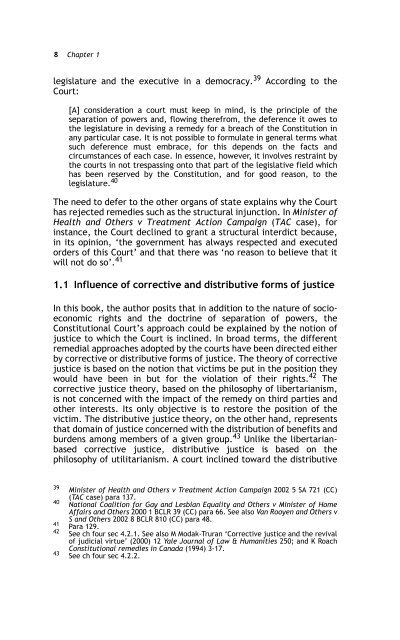LITIGATING SOCIO-ECONOMIC RIGHTS IN SOUTH AFRICA - PULP
LITIGATING SOCIO-ECONOMIC RIGHTS IN SOUTH AFRICA - PULP
LITIGATING SOCIO-ECONOMIC RIGHTS IN SOUTH AFRICA - PULP
You also want an ePaper? Increase the reach of your titles
YUMPU automatically turns print PDFs into web optimized ePapers that Google loves.
8 Chapter 1<br />
legislature and the executive in a democracy. 39 According to the<br />
Court:<br />
[A] consideration a court must keep in mind, is the principle of the<br />
separation of powers and, flowing therefrom, the deference it owes to<br />
the legislature in devising a remedy for a breach of the Constitution in<br />
any particular case. It is not possible to formulate in general terms what<br />
such deference must embrace, for this depends on the facts and<br />
circumstances of each case. In essence, however, it involves restraint by<br />
the courts in not trespassing onto that part of the legislative field which<br />
has been reserved by the Constitution, and for good reason, to the<br />
legislature. 40<br />
The need to defer to the other organs of state explains why the Court<br />
has rejected remedies such as the structural injunction. In Minister of<br />
Health and Others v Treatment Action Campaign (TAC case), for<br />
instance, the Court declined to grant a structural interdict because,<br />
in its opinion, ‘the government has always respected and executed<br />
orders of this Court’ and that there was ‘no reason to believe that it<br />
will not do so’. 41<br />
1.1 Influence of corrective and distributive forms of justice<br />
In this book, the author posits that in addition to the nature of socioeconomic<br />
rights and the doctrine of separation of powers, the<br />
Constitutional Court’s approach could be explained by the notion of<br />
justice to which the Court is inclined. In broad terms, the different<br />
remedial approaches adopted by the courts have been directed either<br />
by corrective or distributive forms of justice. The theory of corrective<br />
justice is based on the notion that victims be put in the position they<br />
would have been in but for the violation of their rights. 42 The<br />
corrective justice theory, based on the philosophy of libertarianism,<br />
is not concerned with the impact of the remedy on third parties and<br />
other interests. Its only objective is to restore the position of the<br />
victim. The distributive justice theory, on the other hand, represents<br />
that domain of justice concerned with the distribution of benefits and<br />
burdens among members of a given group. 43 Unlike the libertarianbased<br />
corrective justice, distributive justice is based on the<br />
philosophy of utilitarianism. A court inclined toward the distributive<br />
39 Minister of Health and Others v Treatment Action Campaign 2002 5 SA 721 (CC)<br />
(TAC case) para 137.<br />
40<br />
National Coalition for Gay and Lesbian Equality and Others v Minister of Home<br />
Affairs and Others 2000 1 BCLR 39 (CC) para 66. See also Van Rooyen and Others v<br />
S and Others 2002 8 BCLR 810 (CC) para 48.<br />
41<br />
Para 129.<br />
42 See ch four sec 4.2.1. See also M Modak-Truran ‘Corrective justice and the revival<br />
of judicial virtue’ (2000) 12 Yale Journal of Law & Humanities 250; and K Roach<br />
Constitutional remedies in Canada (1994) 3-17.<br />
43 See ch four sec 4.2.2.
















